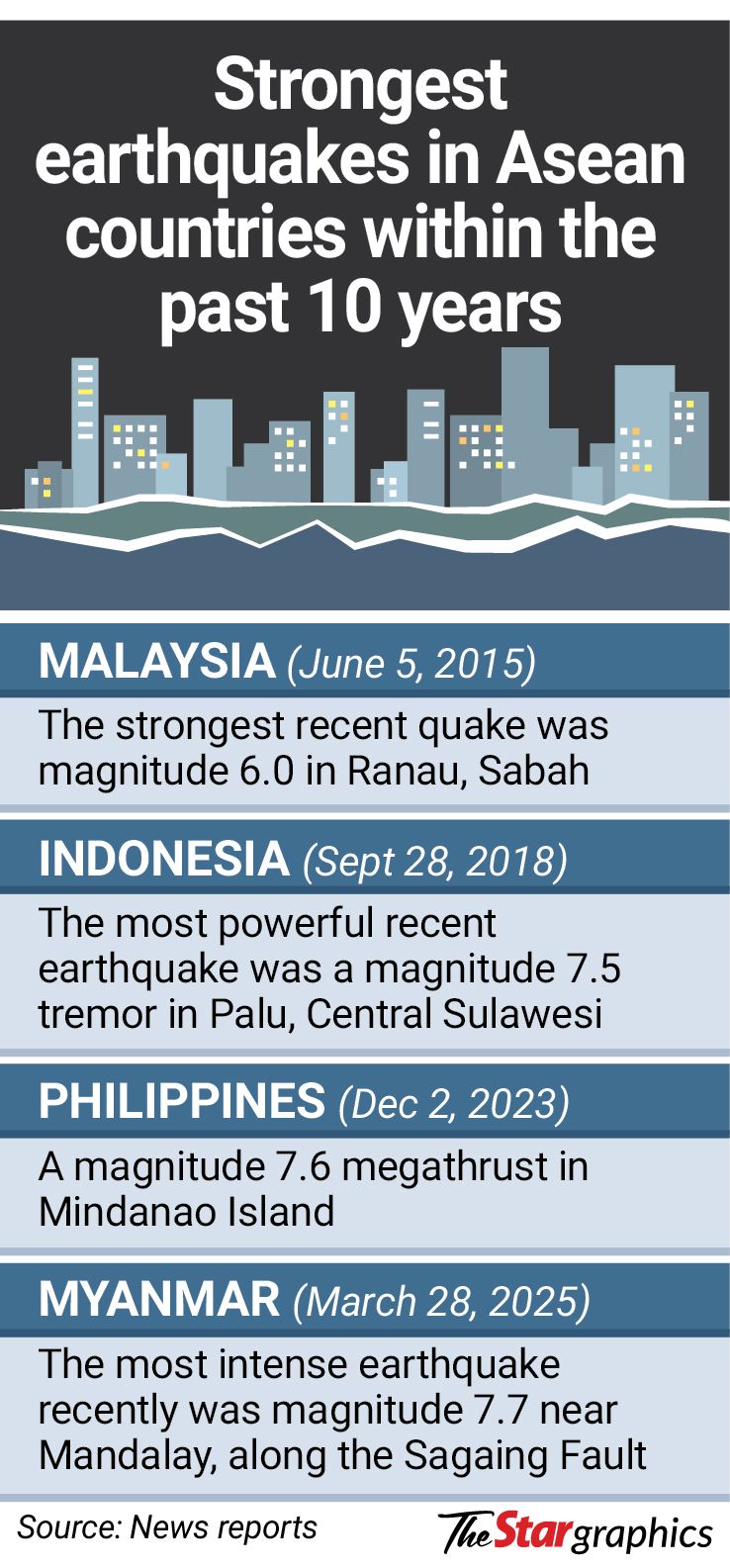September 4, 2025
PETALING JAYA – Malaysia needs to revisit its disaster preparedness policies, and use artificial intelligence (AI) in earthquake monitoring and emergency response systems, say experts.
While Malaysia lies outside the Pacific Ring of Fire, at least 59 earthquakes have been recorded in Peninsular Malaysia since 1922, with Borneo seeing more frequent activity.
ALSO READ : Two seismic stations, exercises planned
Most recently, at least five tremors were recorded in Segamat, Johor, beginning with the first at 6.13am on Aug 24 with a magnitude of 4.1, followed by one at 8.59am on Wednesday (Aug 27, 3.2), 7.56pm on Thursday (Aug 28, 2.5), 4.24am on Friday (Aug 29, 3.4) and 7.29am on Saturday (Aug 30, 2.7).

GRAPHICS: THE STAR
Last night, a 2.9-magnitude tremor was detected at 6.39pm in Parit Sulong, about 80km from Segamat.
There are several potentially active fault lines in the country, especially in Sabah, with one or two possibly active in the peninsula, says Dr Lim Choun Sian, head of the Geological Hazards Programme (SEADPRI) at Universiti Kebangsaan Malaysia.
He said AI is a valuable tool for solving seismology problems.
“But to build an effective AI early warning system, extensive data collection is needed, especially geological and soil data and a sensor network including seismographs and other detection devices,” he said.
ALSO READ : Preparing for the unpredictable
Some seismic events may be misinterpreted as human-induced quakes, such as those linked to reservoirs.
“Detecting the exact fault causing an earthquake is difficult. Faults are naturally found in rocks, but many are ancient and inactive and don’t cause earthquakes,” he said.
He added that mild earthquakes in Malaysia typically do not cause ground ruptures like the ones seen in Myanmar.
ALSO READ : Segamat’s heritage buildings on shaky ground
Lim advised checking buildings built before earthquake-resistant standards were introduced. However, he added that most buildings in Malaysia should be able to withstand magnitudes of less than 5.0, which is the strongest the country has seen.
However, in areas like Sabah, buildings and infrastructure may need retrofitting.
“Malaysia ranks among the top seven safest countries from major earthquakes, although it is not completely free from risk,” he said.
Zahir Hassan, the All-Party Parliamentary Group Malaysia Disaster Risk Management chairman, said the situation must be addressed in a holistic manner.
“Disaster risk management and reduction must take a holistic approach at every stage of the disaster management cycle namely, response, recovery, mitigation and preparedness,” he said.
From an engineering, data and science aspect, the tremors in Segamat should be taken as early indicators that require further study to determine the changes in the area.
Zahir, who is Wangsa Maju MP, said while the use of AI is critical, it should not be limited to the Global Navigation Satellite System or InSAR, (Interferometric Synthetic Aperture Radar), a technique for mapping ground deformation using radar images of the Earth’s surface from satellites.
“The enforcement of building resistance by Eurocode8 (EC8) from 2021 is needed, along with assessments on all existing or old buildings,” he said.
EC8 applies to the design and construction of buildings and other civilian infrastructure in seismic regions.
Dr Zakaria Endut, senior lecturer on economic geology, structural geology and geochemistry at Universiti Sains Malaysia, believed that only areas with a history of earthquakes should be equipped with early detection systems.
“Malaysia generally does not experience large earthquakes due to its location away from active plate boundaries,” he said, adding that Malaysia has already adopted EC8 standards.
Instead, he called for the creation of a National Geological Disaster Centre to look at local earthquakes and other disasters.
“The centre was proposed to monitor the effectiveness of the early warning system for tsunamis, floods and landslides.
“However, this centre can also be responsible for other disasters such as local earthquakes. It can integrate a broader disaster preparedness and multi-hazard early warning system,” he added.

